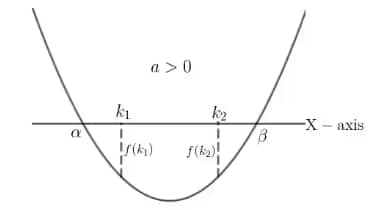Location of Roots: Quadratic Equation, Theorem, Formula, Questions
Understanding the location of roots of quadratic equations is a vital concept in algebra that plays a significant role in solving mathematical problems across physics, engineering, and economics. In mathematics, this topic helps identify whether the roots are positive, negative, real, or lie on opposite sides of the origin. For students preparing for competitive exams or looking to strengthen their algebra basics, mastering the location of roots in quadratic equations is essential. In this article, we explain the concept with clear explanations, examples, and key conditions to help you grasp it easily.
This Story also Contains
- Introduction to Location of Roots
- Standard Form of a Quadratic Equation
- Different Cases of Roots of a Quadratic Equation
- Sum and Product of Roots of a Quadratic Equation
- Graphical Interpretation of Location of Roots
- List of Topics related to Location of roots
- NCERT Useful Resources
- Practice Questions on the location of roots
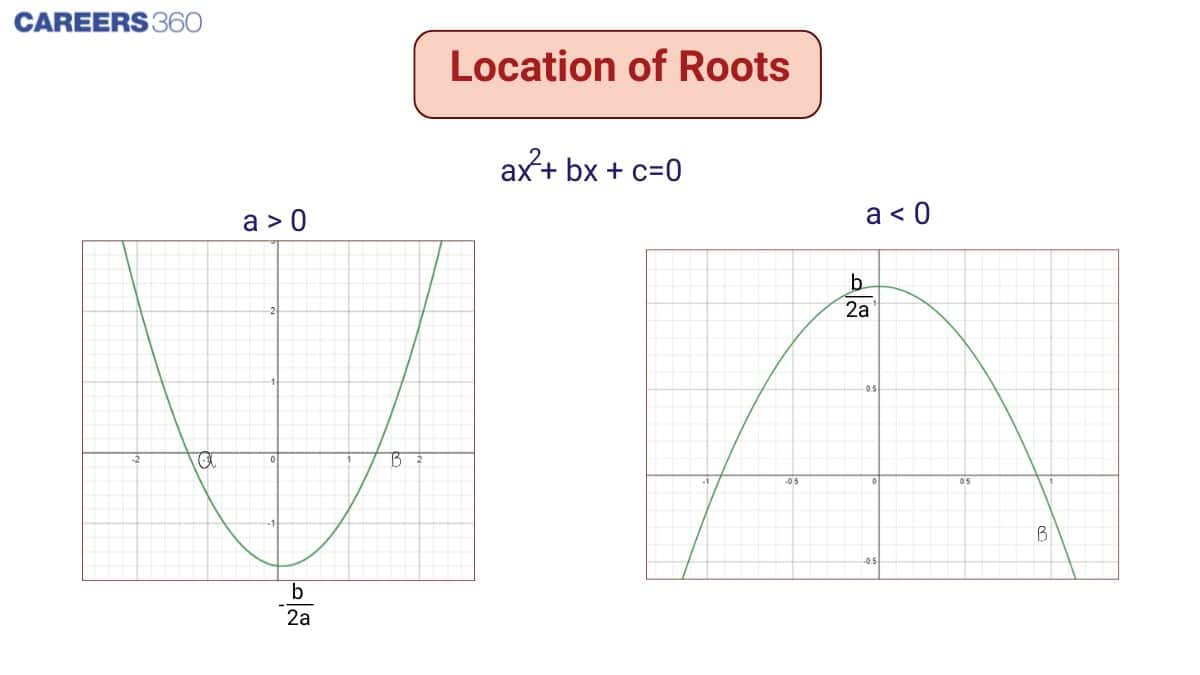
Introduction to Location of Roots
The location of roots helps determine where the solutions (roots) of a quadratic equation lie on the number line—whether they are positive, negative, real, complex, or on opposite sides of a point (like the origin or a specific number). Instead of finding the exact values of the roots, the goal is to infer their signs and relative positions using logical conditions and basic algebraic tools.
What is the Location of Roots?
Given a quadratic equation:
$ax^2 + bx + c = 0$
Let the roots be $x_1$ and $x_2$. The location of roots refers to whether:
- Both roots are positive
- Both roots are negative
- Roots lie on opposite sides of zero or another number
- Roots are real and distinct, equal, or complex
Key formulas to analyze root location:
- Discriminant: $D = b^2 - 4ac$
- Sum of roots: $x_1 + x_2 = -\frac{b}{a}$
- Product of roots: $x_1 \cdot x_2 = \frac{c}{a}$
Basic conditions:
- Roots are real and distinct if $D > 0$
- Roots are real and equal if $D = 0$
- Roots are complex (non-real) if $D < 0$
- Both roots are positive if $x_1 + x_2 > 0$ and $x_1 \cdot x_2 > 0$
- Both roots are negative if $x_1 + x_2 < 0$ and $x_1 \cdot x_2 > 0$
- Roots lie on opposite sides of 0 if $x_1 \cdot x_2 < 0$
Standard Form of a Quadratic Equation
Quadratic equations are algebraic expressions of degree 2. Understanding their structure and solutions is essential before exploring the location of roots. The standard form of a quadratic equation is:
$ax^2 + bx + c = 0$
where $a$, $b$, and $c$ are real constants, and $a \ne 0$ (since the equation must be quadratic).
To determine or locate the roots of a function, various techniques are applied. These include the sign change method for roots, graphical method to locate roots, and Rolle’s theorem and root location approaches. Students also use the intermediate value theorem for roots and Descartes' Rule of Signs—known as the root location using Descartes' Rule—to estimate root intervals.
When dealing with polynomials, one often asks, "What is meant by location of roots?" or "How to find approximate location of roots?" The answer lies in applying a combination of analytical and visual tools. Whether it’s finding location of roots of equation or applying a root location method to a specific scenario, a clear understanding of these strategies makes solving quadratic and higher-degree equations more intuitive.
Thus, learning how to find location of roots of a polynomial is a fundamental step in mastering algebra.
Meaning of Roots or Zeros of a Quadratic Equation
The roots (or zeros) of a quadratic equation are the values of $x$ that satisfy:
$ax^2 + bx + c = 0$
These roots represent the x-intercepts of the parabola given by $f(x) = ax^2 + bx + c$. Understanding the location of roots is crucial when analysing the graph of a function.
The roots can be found using the quadratic formula:
$x = \frac{-b \pm \sqrt{b^2 - 4ac}}{2a}$
To further explore how to find location of roots of a polynomial, methods like the graphical method to locate roots, the sign change method for roots, and the intermediate value theorem for roots are often applied. These techniques help in finding location of roots of equation and give insights into their approximate values.
Real vs Complex Roots
The discriminant $D = b^2 - 4ac$ determines the nature of the roots:
- If $D > 0$, roots are real and distinct
- If $D = 0$, roots are real and equal
- If $D < 0$, roots are complex conjugates
This classification is crucial for analyzing where and how the roots appear on the number line or complex plane.
Conditions for Location of Roots in Quadratic Equations
To determine the location of roots in quadratic equations, algebraic tests involving the coefficients and discriminant are applied. These help identify how to find location of roots of a polynomial and whether the roots lie on the positive or negative side of the number line.
Approaches like the sign change method for roots, intermediate value theorem for roots, and Rolle’s theorem and root location are commonly used in this context. Such tools aid in finding location of roots of equation and understanding the nature and position of the solutions.
Discriminant and Nature of Roots
As defined: $D = b^2 - 4ac$
Use it to decide:
- $D > 0$: Two real and distinct roots
- $D = 0$: Real and equal roots
- $D < 0$: No real roots (complex)
Real roots are necessary to discuss their location on the number line.
Sign of Roots Based on Coefficients
Using formulas:
- Sum of roots: $x_1 + x_2 = -\frac{b}{a}$
- Product of roots: $x_1 \cdot x_2 = \frac{c}{a}$
Conditions:
- If $x_1 + x_2 > 0$ and $x_1 \cdot x_2 > 0$ ⇒ both roots are positive
- If $x_1 + x_2 < 0$ and $x_1 \cdot x_2 > 0$ ⇒ both roots are negative
- If $x_1 \cdot x_2 < 0$ ⇒ roots lie on opposite sides of zero
Location of Roots on the Number Line
To determine where the roots lie:
- Check sign of $f(x)$ at a point (like $f(0) = c$)
- Analyze the sign of the product $x_1 \cdot x_2$
- Graphical approach: roots are x-intercepts of the parabola
Quick checks:
- $f(0) = c > 0$ and $x_1 \cdot x_2 < 0$ : roots are on opposite sides of 0
- $x_1 + x_2$ and $x_1 \cdot x_2$ both positive : roots lie on the positive side
- Both positive or both negative depends on sign consistency of the function
Importance in Algebra and Real-World Applications
The concept of location of roots is widely used in:
- Algebra: For solving inequalities and analyzing signs of expressions without solving the equation fully.
- Graphing: Understanding whether the parabola intersects the x-axis and where.
- Inequalities: For checking when $ax^2 + bx + c > 0$ or $< 0$ based on root positions.
- Physics and Engineering: To ensure solutions (e.g., time, speed) are positive and physically meaningful.
- Economics: For identifying profit/loss break-even points based on quadratic cost/revenue functions.
Different Cases of Roots of a Quadratic Equation
The nature and location of roots of a quadratic equation $ax^2 + bx + c = 0$ largely depend on the discriminant $D = b^2 - 4ac$. Understanding this helps in finding location of roots of equation more effectively.
Different cases—real and distinct, real and equal, or complex roots—affect how to locate roots of a function both algebraically and visually. Methods like the graphical method to locate roots, Descartes' Rule of Signs, and the intermediate value theorem for roots can assist in analysing these scenarios.
Case 1: $D > 0$ – Real and Distinct Roots
- Roots are real and unequal.
- If $\frac{c}{a} > 0$ and $\frac{-b}{a} > 0$, both roots are positive.
- If $\frac{c}{a} > 0$ and $\frac{-b}{a} < 0$, both roots are negative.
- If $\frac{c}{a} < 0$, roots lie on opposite sides of origin.
Case 2: $D = 0$ – Real and Equal Roots
- Roots are real and repeated
- Single root is given by: $x = \frac{-b}{2a}$
- Root is positive if $\frac{-b}{2a} > 0$, and negative if $\frac{-b}{2a} < 0$.
Case 3: $D < 0$ – Imaginary Roots
- Roots are non-real (complex conjugate pair).
- No real root exists ⇒ no location on the number line.
Case 4: $D$ is a Perfect Square
- Roots are real and rational
- Examples: $D = 4$, $9$, $16$, etc.
- Occurs often in factorable quadratic equations
Case 5: $D$ is Not a Perfect Square
- Roots are real and irrational.
- Cannot be simplified to a rational number.
- Roots still follow the same sign rules using sum and product.
Sum and Product of Roots of a Quadratic Equation
Let $\alpha$ and $\beta$ be the roots of the quadratic equation:
$ax^2 + bx + c = 0$
Then:
Sum of Roots Formula
$\alpha + \beta = \frac{-b + \sqrt{D}}{2a} + \frac{-b - \sqrt{D}}{2a}$
$= \left( \frac{-b}{2a} + \frac{\sqrt{D}}{2a} \right) + \left( \frac{-b}{2a} - \frac{\sqrt{D}}{2a} \right)$
$= \frac{-2b}{2a} = \frac{-b}{a}$
So, sum of roots:
$\alpha + \beta = \frac{-b}{a}$
Product of Roots Formula
$\alpha \cdot \beta = \left( \frac{-b + \sqrt{D}}{2a} \right) \cdot \left( \frac{-b - \sqrt{D}}{2a} \right)$
$= \frac{(-b)^2 - (\sqrt{D})^2}{(2a)^2}= \frac{b^2 - D}{4a^2}$
$= \frac{b^2 - (b^2 - 4ac)}{4a^2}$
$ = \frac{4ac}{4a^2} = \frac{c}{a}$
So, product of roots:
$\alpha \cdot \beta = \frac{c}{a}$
Forming a Quadratic Equation from Roots
Given $\alpha + \beta$ and $\alpha \cdot \beta$, the quadratic equation is:
$x^2 - (\alpha + \beta)x + (\alpha \cdot \beta) = 0$
Substitute values:
$x^2 - \frac{b}{a}x + \frac{c}{a} = 0$
Multiply entire equation by $a$:
$ax^2 - bx + c = 0$
This is the original quadratic equation reconstructed using sum and product of roots.
Graphical Interpretation of Location of Roots
Now, the question is: how to find the location of roots? The graphical method to locate roots provides a visual way to understand what is meant by location of roots in a quadratic equation. For any equation of the form $f(x) = ax^2 + bx + c$, the graph is a parabola, and its x-intercepts indicate the real roots.
Whether the parabola cuts the x-axis at two points, touches it once, or does not intersect at all depends on the discriminant. This method is especially helpful for finding location of roots of equation and determining if they are positive, negative, real, or complex.
Let $f(x) = ax^2 + bx + c$, where $a$, $b$, and $c$ are real numbers and $a \ne 0$. Let $x_1$ and $x_2$ be the roots of the equation, and let $k$ be a real number.
1. If both roots of $\mathrm{f}(\mathrm{x})$ are less than k then
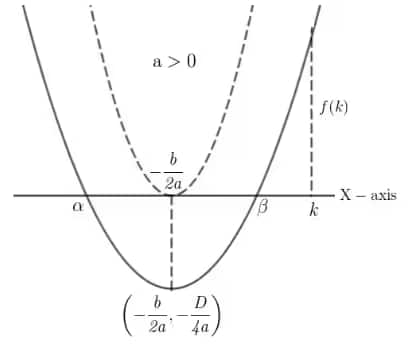
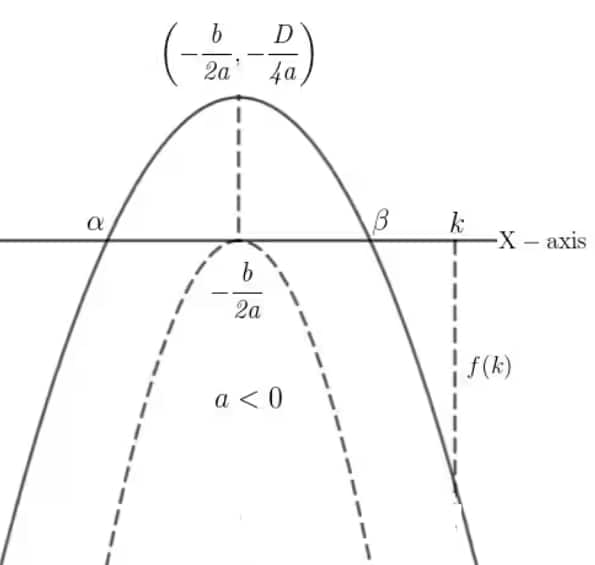
i) $\mathrm{D} \geq 0$ (as the real roots may be distinct or equal)
ii) $af( k)>0$ (In both the cases $af(\mathrm{k})$ is positive, as in second case if a $<0$ then $\mathrm{f}(\mathrm{k})<0$, so multiplying two $-ve$ values will give us a positive value)
iii) $k>\frac{-b}{2 a}$ since $\frac{-b}{a}$ will lie between $x_1$ and $x_2$, and $x_1$, $x_2$ are less than k so $\frac{-\mathrm{b}}{2 \mathrm{a}}$ will be less than k .
2. If both roots of $f(x)$ are greater than $k$
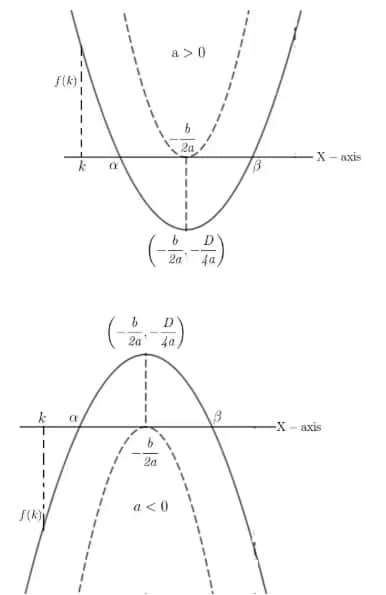
i) $\mathrm{D} \geq 0$ (as the real roots may be distinct or equal)
ii) $\mathrm{af}(\mathrm{k})>0$ (In both the cases af( k$)$ is positive, as in second case if a $<0$ then $\mathrm{f}(\mathrm{k})<0$, so multiplying two -ve values will give us a positive value)
iii) $k<\frac{-\mathrm{b}}{2 \mathrm{a}}$ since $\frac{-\mathrm{b}}{2 \mathrm{a}}$ will lie between $x_1$ and $x_2$, and $x_1$, $x_2$ are greater than k so $\frac{-\mathrm{b}}{2 \mathrm{a}}$ will be greater than k .
Condition for number $k$
Let $\mathrm{f}(\mathrm{x})=\mathrm{ax}^2+\mathrm{bx}+\mathrm{c}$ where $\mathrm{a}, \mathrm{b}, \mathrm{c}$ are real numbers and ' a ' is non-zero number. Let $x_1$ and $x_2$ be the real roots of the function. And let k is any real number. Then:
3. If $k$ lies between the root $x_1$ and $x_2$
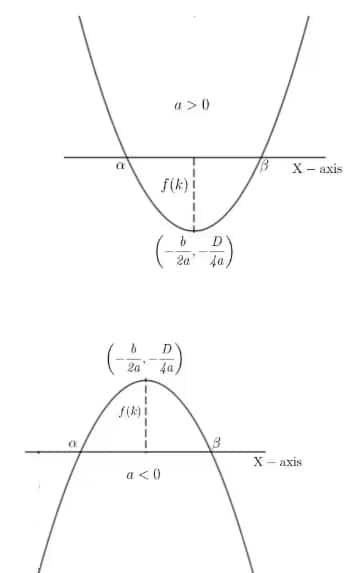
$\mathrm{af}(\mathrm{k})<0$
As if $a<0$ then $f(k)>0$. So multiplying one $-ve$ and one $+ve$ value will give us negative value)
Condition for number $k_1$ and $k_2$
Let $f(x)=a x^2+b x+c$ where a,b,c are real numbers and ‘a’ is non-zero number. Let $x_1$ and $x_2$ be the real roots of the function. And let $k_1, k_2$ be any two real numbers. Then:
4. If exactly one root of $f(x)$lies in between the number $k_1, k_2$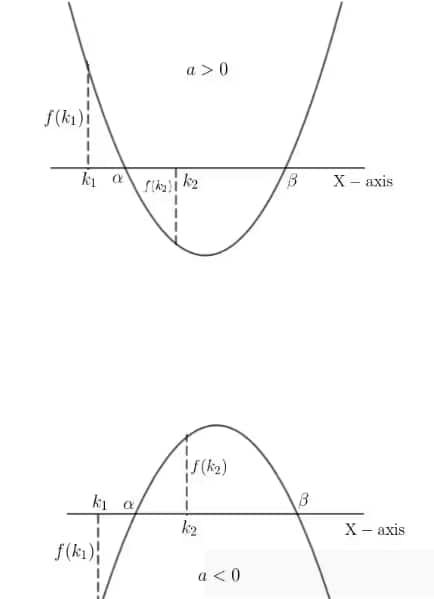
$f\left(k_1\right) f\left(k_2\right)<0$ as for one value of k, we will have +ve value of$f(x)$ and for other values of $k$, we will have $-ve$ value of $f(x)$ (here $x_1$ < $x_2$)
Condition on number $k_1, k_2$
Let $\mathrm{f}(\mathrm{x})=\mathrm{ax}{ }^2+\mathrm{bx}+\mathrm{c}$, where $\mathrm{a}, \mathrm{b}, \mathrm{c}$ are real numbers and '$a$ ' is non-zero number. Let $x_1$ and $x_2$ be the roots of the function. And let $k 1, k_2$ be any two real numbers. Then
5. If both roots lie between $k_1, k_2$
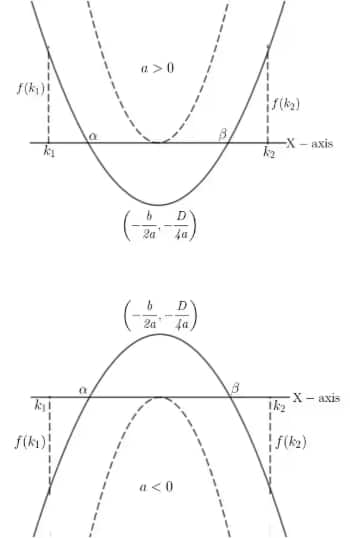
i) $\mathrm{D} \geq 0$ (as the real roots may be distinct or equal)
ii) $k_1<\frac{-b}{2 a}<k_2$, where $a \leq 3$ and $k_1<k_2$
6. If $k_1, k_2$ lies between the roots
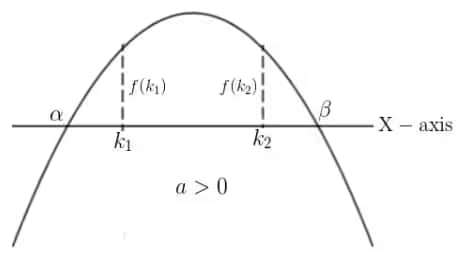 $\mathrm{af}\left(\mathrm{k}_1\right)<0$ and $\mathrm{af}\left(\mathrm{k}_2\right)<0$
$\mathrm{af}\left(\mathrm{k}_1\right)<0$ and $\mathrm{af}\left(\mathrm{k}_2\right)<0$
Solved Examples Based on Location of Roots
Example 1: Number of +ve integer values of '$a$' for which $x^2+x+a=0$ has roots of opposite sign is.......
Solution: Roots are of opposite sign -
$\frac{c}{a}<0, D=b^2-4 a c>0$
$D>0$
$\frac{c}{a}<0 \Rightarrow 1-4 a>0$
$\frac{a}{1}<0$
$\Rightarrow a<\frac{1}{4}$
$\Rightarrow a<0$, hence, the number of positive integer values is 0.
a) $-2<m<0$
b) $m>3$
c) $-1<m<3$
d) $1<m<4$
Solution:
For both roots to exist,
$D>0$
$D=b^2-4 a c$
$\Rightarrow D=4 m^2-4\left(m^2-1\right)$
$\Rightarrow D=4$
Here, $D>0$
Now,
$f(-2)>0 \text { and } f(4)>0$
$\Rightarrow 4+4 m+m^2-1>0 \text { and } 16-8 m+m^2-1>0$
$\Rightarrow m^2+4 m+3>0 \quad \text { and } \quad m^2-8 m+15>0$
$\Rightarrow(m+3)(m+1)>0 \quad(m-5)(m-3)>0$
$\Rightarrow m \in(-\infty,-3) \cup(-1, \infty) \text { and } m \in(-\infty, 3) \cup (5, \infty)$
Taking the intersection of the above intervals,
$m \epsilon(-1,3)$
Therefore ' m ' should belong to $(-1,3)$ for roots to be between -2 and 4 .
Example 3: What is the value of $m$ so that both roots of the equation $x^2+m x+1$ are less than unity?
Solution:
Since the roots are less than unity, it implies that:
$af(1) > 0$, where $a = 1$ and $f(1) = m + 2$
So, $m + 2 > 0 \Rightarrow m > -2$ ...(i)
For two distinct real roots to exist, the discriminant must be positive:
$D > 0 \Rightarrow m^2 - 4 > 0$
So, $m > 2$ or $m < -2$ ...(ii)
Now, combining (i) and (ii):
From (i): $m > -2$
From (ii): $m > 2$ or $m < -2$
The common values satisfying both are: $m > 2$
Hence, the final solution is: $m > 2$
Solution: If one root is less than 2
$D>0$ and $f(2)<0$
$\quad D>0$
$(m-3)^2-4 m>0$
$(m-1)(m-9)>0$
$m \in(-\infty, 1) \cup(9, \infty)$
$\quad f(2)<0$
$4-2(m-3)+m<0$
$m>10$
on combining
$m \in(10, \infty)$
Solution: If exactly one root of the equation $x^2+2 a x+a^2-1=0$ lies between 4 and 6 then, $\mathrm{f}(4) \cdot \mathrm{f}(6)<0$.
$\left(16+8 a+a^2-1\right)\left(36+12 a+a^2-1\right)<0$
$(a+5)(a+3)(a+7)(a+5)<0$
$(a+3)(a+7)(a+5)^2<0$
$(a+7)(a+3)<0$
$a \in(-7,-3)$
List of Topics related to Location of roots
Here is a list of key topics related to the location of roots in quadratic equations and polynomials, including concepts like remainder theorem, rational and irrational inequalities, along with exponential and logarithmic equations in quadratic form.
NCERT Useful Resources
Explore essential NCERT study materials for Complex Numbers and Quadratic Equations, including detailed solutions, concise revision notes, and curated exemplar problems. These resources are tailored to help you strengthen your conceptual understanding and prepare effectively for board and competitive exams.
NCERT Solutions for Chapter 4 Complex Numbers and Quadratic Equations
NCERT Notes for Chapter 4 Complex Numbers and Quadratic Equations
NCERT Exemplar for Chapter 4 Complex Numbers and Quadratic Equations
Practice Questions on the location of roots
To help you strengthen your understanding of the topic, we’ve included a few practice questions on location of roots of quadratic equations. These will test your grasp of root positions, signs, and related conditions using standard formulas.
To practice location of roots-based questions, click here.
You can practice the next topics of Complex Numbers and Quadratic Equations below:
Frequently Asked Questions (FAQs)
The location of roots influences the range of a quadratic function f(x) = ax² + bx + c as follows:
Transformations of qua
Root multiplicity in quadratic equations refers to how many times a root occurs:
The location of roots is closely related to the extreme values of a quadratic function:
For systems of quadratic equations, the location of roots theorem can be applied to each equation individually and then combined:
The vertex form of a quadratic equation, f(x) = a(x - h)² + k, where (h, k) is the vertex, relates to root location:
Symmetry in quadratic functions is closely tied to the location of roots:
The location of roots directly corresponds to the factored form of a quadratic expression:
The location of roots theorem helps analyze quadratic inequalities ax² + bx + c ⋚ 0 by:
The leading coefficient 'a' in a quadratic equation ax² + bx + c = 0 affects the roots as follows:
